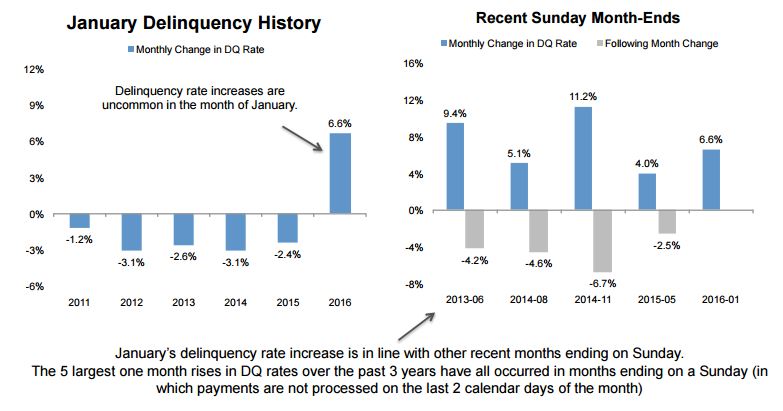 Most of the news regarding housing fundamentals has been positive in the last two years or so. But mortgage delinquencies rose month-over-month in January for the first time since the housing recovery began, according to data reported by Black Knight Financial Services on Monday.
Most of the news regarding housing fundamentals has been positive in the last two years or so. But mortgage delinquencies rose month-over-month in January for the first time since the housing recovery began, according to data reported by Black Knight Financial Services on Monday.
According to the January 2016 Black Knight Mortgage Monitor, the share of delinquent mortgage loans (30 days or more overdue but not in foreclosure) has declined by an average of 2 percent month-over-month every January since 2011—until this year. In January 2016, the share of delinquencies shot up by 6.6 percent, an increase of 167,000 properties, according to Black Knight.
With January’s increase, the total of delinquent properties nationwide was approximately 2.57 million, or about 5.1 percent of all residential properties with a mortgage, Black Knight reported.
Will delinquencies bounce back in February? Possibly, according to Black Knight.
“It is typical to see a partial, but not full, recovery the following month,” the report stated.
 The fact that January ended on a Sunday contributed to the increase in delinquencies because servicers are unable to process any payments made on the last two days of the month. According to Black Knight, the five largest over-the-month increases in the last three years have all come in months that ended on a Sunday.
The fact that January ended on a Sunday contributed to the increase in delinquencies because servicers are unable to process any payments made on the last two days of the month. According to Black Knight, the five largest over-the-month increases in the last three years have all come in months that ended on a Sunday.
The roll rates, or loans rolling into a more delinquent status, increased across all categories in January, with the more pronounced increase occurring in the early-stage delinquencies. The number of borrowers who became 30-days delinquent in January totaled 580,000, which was a 28 percent increase (129,000 loans) from the previous month. Loans that rolled from 30- to 60-days delinquent increased by 11 percent in January, while the number of loans that rolled from 60- to 90-days delinquent rose by 7 percent.
The share of loans that rolled from 90 days delinquent to foreclosure declined from December to January, since the Sunday month-end had no impact.
The combination of the increased roll rates with a drop in loan cures, or those loans that rolled from delinquent status to current), contributed to January’s rise in delinquency rate. The decline in loan cures was also due to January ending on Sunday, according to Black Knight. As was the case with delinquencies, the drop in cures was more pronounced among loans in earlier stages of delinquency. Loans that were 1 to 2 months delinquent experienced a 20 percent decline from December to January, while loans that were 3 to 5 months delinquent experienced a decline in cures of 9 percent. For loans that were 6 or more months delinquent, the decline in cures was 13 percent. The number of loans that cured from active foreclosure also declined by 9 percent from December to January, according to Black Knight.
Click here to view the entire mortgage monitor.

 DSNews The homepage of the servicing industry
DSNews The homepage of the servicing industry










